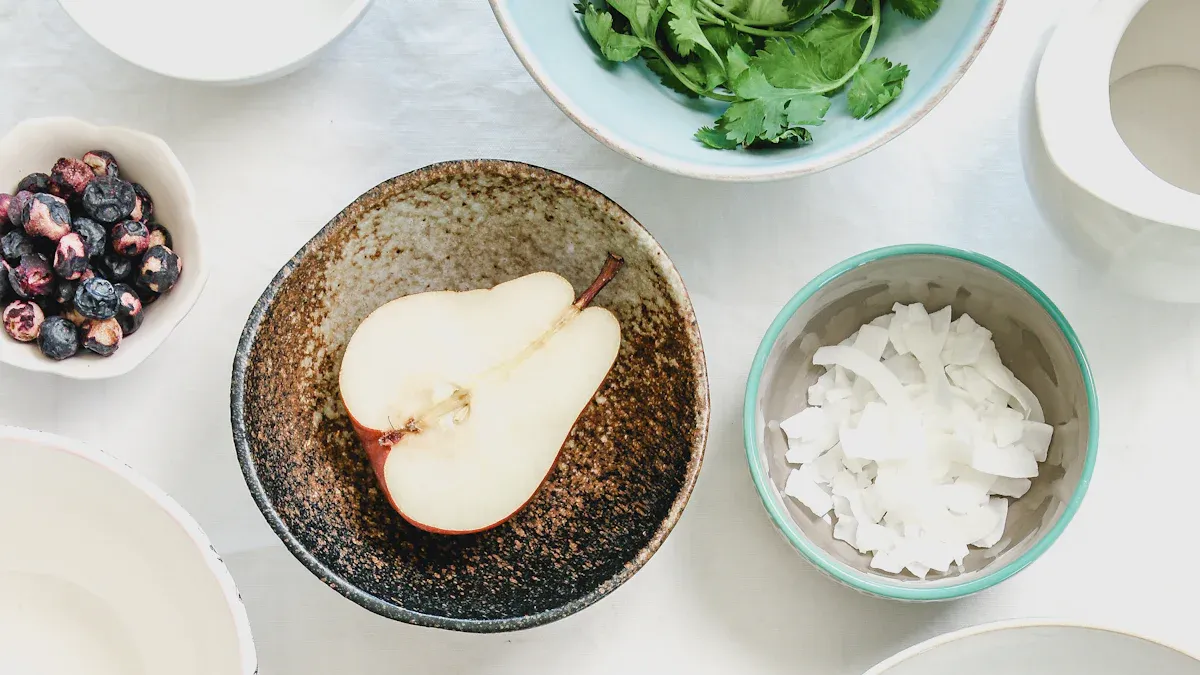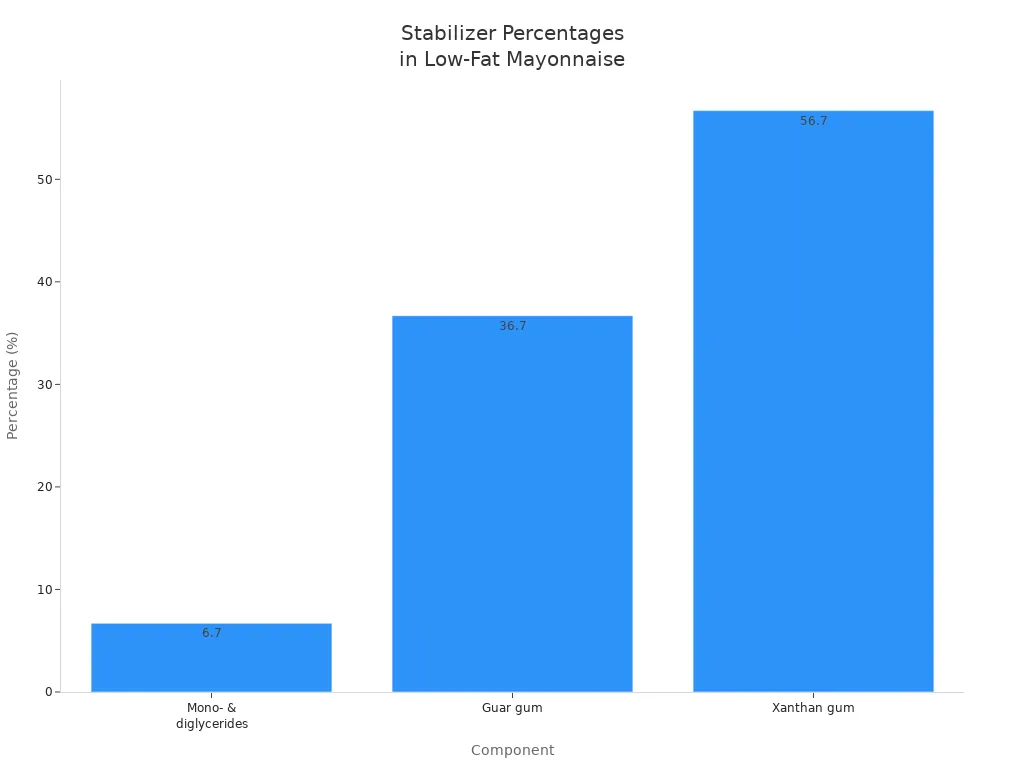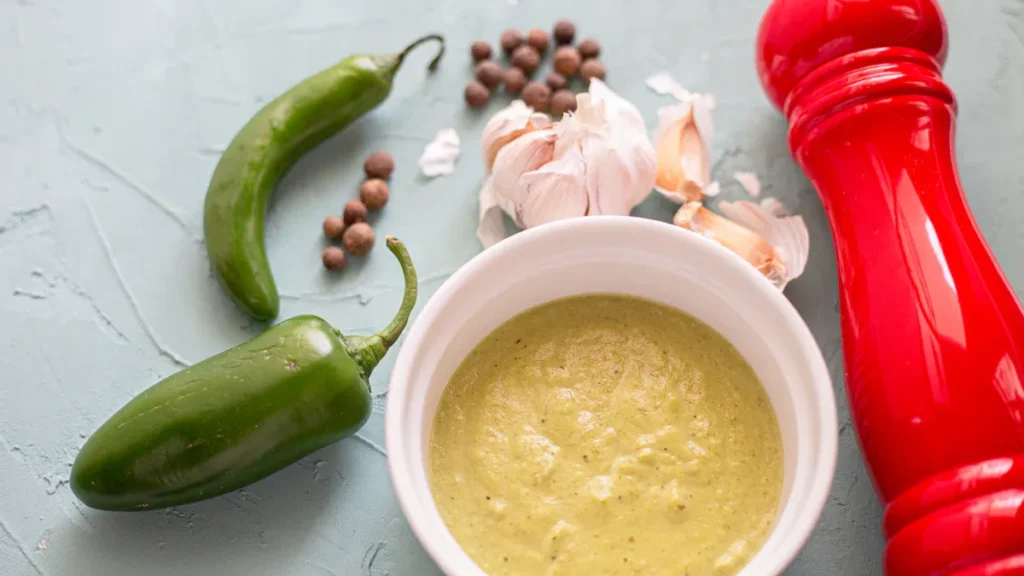
You face a unique challenge when you try to produce low-fat mayonnaise. Removing fat changes the texture, goût, and appearance that customers expect. Fat helps keep mayonnaise stable and creamy, so reducing it can make the product less firm and smooth. To solve this, you can use special ingredients like hydrocolloids to improve thickness and stability. Avancé, customizable equipment also helps you control each step with precision. The growing global demand for healthier foods shows why you need a Technical Guide for success.
Principaux à retenir
Follow a structured process to produce low-fat mayonnaise. Each step, from formulating premixes to cooling, is crucial for achieving the right texture and taste.
Address common challenges like texture and stability by using fat replacers and hydrocolloids. These ingredients help maintain creaminess and prevent separation.
Invest in advanced equipment like vacuum emulsifiers and inline viscosity monitors. These tools enhance production efficiency and ensure consistent quality.
Conduct regular sensory testing to ensure your mayonnaise meets customer expectations. This includes checking for texture, saveur, and color uniformity.
Stay updated on regulatory standards to ensure compliance. Accurate labeling and ingredient approval are essential for consumer safety and trust.
Technical Guide Overview
Key Production Steps
You need to follow a clear process when making low-fat mayonnaise. Each step in the Technical Guide helps you create a product with the right texture and taste. Here is a table that shows the main steps you should take:
Étape | Description |
|---|---|
1 | Formulate premixes with dry ingredients, microcrystalline cellulose, gum, eau, and whey or egg. |
2 | Mill microcrystalline cellulose to get a uniform mix. |
3 | Combine all premixes in a slurry tank with other ingredients. |
4 | Blend the slurry for at least five minutes. |
5 | Cook the slurry at 175°F to 200°F for 15 à 75 seconds. |
6 | Cool the cooked slurry to 70°F. |
7 | Mill again to achieve a smooth texture. |
You can see that each step in the Technical Guide builds on the last. You must pay attention to temperature and mixing times. These details help you get a smooth and stable mayonnaise.
Main Challenges
When you reduce fat in mayonnaise, you face several challenges. The Technical Guide points out three main issues: texture, stabilité, and mouthfeel. The table below explains these challenges and how you can solve them:
Défi | Description | Strategy to Address Challenges |
|---|---|---|
Texture | Less fat makes the product less creamy. | Use fat replacers to mimic the feel of fat. |
Stabilité | Lower fat weakens the emulsion and can cause separation. | Try water-in-oil-in-water emulsions. |
Mouthfeel | Reduced fat gives a less satisfying mouthfeel than regular mayonnaise. | Add hydrocolloids to improve viscosity. |
Conseil: You can improve your results by testing different ingredients and mixing methods. The right approach helps you overcome these common problems.
By following the Technical Guide, you can address these challenges and produce a high-quality low-fat mayonnaise.
Low-Fat Mayonnaise Ingredients

Fat Substitutes and Replacers
You can use many ingredients to replace fat in mayonnaise. These substitutes help you keep the creamy texture and taste that people expect. The table below shows some of the most effective options:
Ingredient Type | Properties | Recommended Amount (by weight) |
|---|---|---|
Uncooked Rice Starch | Fat mimetic properties, desired opacity | 1-10% (preferably 1-7%) |
Edible Fats (Par exemple, soybean oil) | Can be included up to 20% by weight, preferably 1-15% | 1-15% (if included) |
Other Non-Proteinaceous Particles | Can substitute for rice starch, includes ungelatinized starch, cellulose | N / A |
You can also use yeast protein to improve emulsion stability and texture. Studies show that replacing 20% à 40% of fat with yeast protein gives you mayonnaise with similar properties to full-fat versions. À 40% replacement, you get the highest sensory acceptability and over 95% stabilité de l'émulsion.
Emulsifiers and Stabilizers
You need the right emulsifiers and stabilizers to keep your mayonnaise smooth and stable. Here are some options you can use:
Modified gluten increases emulsion stability and improves sensory properties.
Whey proteins delay droplet coalescence and enhance texture.
Microparticulated whey proteins (like Simplesse™) mimic oil droplets for a creamy mouthfeel.
Choose your emulsifier based on processing conditions, droplet size, and the stability you want.
Large hydrocolloid molecules also help prevent oil and water from separating. They keep your mayonnaise thick, crémeux, and opaque.
Clean Label Options
If you want to make a clean label product, you have several choices:
Healthier oils, such as soybean or avocado oil, can lower bad cholesterol.
Natural antioxidants from fruit flours (like nectarine, apple, or pear) replace preservatives and sugar.
Plant proteins, such as lupin and faba beans, make your mayonnaise suitable for vegans and people with allergies.
Natural preservatives help keep your product fresh without synthetic chemicals.
Manufacturers now use new ingredients like aquafaba and plant-based oils to improve flavor and texture. The Technical Guide recommends these options to help you meet consumer demand for healthier, cleaner products.
Formulation Strategies
Emulsion Design
You need to design a stable emulsion to make low-fat mayonnaise that meets customer expectations. You can use natural emulsifiers like egg yolk and polysaccharide complexes to boost emulsifying properties. Non-thermal processing methods, such as high-pressure processing and high-intensity ultrasound, help preserve these properties. Stabilizers like modified amaranth starch improve stability. Innovative formulations, including yolk-casein-based emulsions and sunflower wax-based oleofoams, allow you to reduce fat while keeping texture. Le tableau ci-dessous montre common emulsion design techniques:
Emulsion Design Technique | Description |
|---|---|
Natural Emulsifiers | Use egg yolk and polysaccharide complexes to enhance emulsifying properties. |
Non-Thermal Processing | Apply high-pressure or ultrasound to preserve emulsion stability. |
Stabilisateurs | Add modified amaranth starch for improved stability. |
Innovative Formulations | Develop yolk-casein or sunflower wax-based emulsions for reduced-fat mayo. |
Pectin and Soy Protein | Solidify oil droplets in low-fat emulsion gels. |
Yolk-Casein Self-Assembly | Create low-fat mayonnaise with high-fat texture. |
Hydrocolloids and Thickeners
Hydrocolloids play a key role in low-fat mayonnaise. You use them to bind water and emulsify ingredients, which prevents syneresis and keeps your product smooth. Thickeners help mimic the function of fat, so you can reduce fat content and still get the volume and texture you want. Le most common hydrocolloids include:
Xanthan gum (from microbial metabolism)
Guar gum (from plant seeds)
Gum arabic (from tree secretion)
Pectin (from fruit rinds)
Gelatin (from animal colloids)
Carrageenan (from algae)
Alginate (from algae)
Cellulose derivatives
Modified starch
You can see how different hydrocolloids affect stability and viscosity in the chart below:

Composant | Percentage | Effect on Properties |
|---|---|---|
Mono- & diglycerides | 6.7% | Contribute to emulsion stability and texture. |
Guar gum | 36.7% | Enhance viscosity and stability of the emulsion. |
Xanthan gum | 56.7% | Most significant impact on stability, viscosité, and acceptance. |
Conseil: You can adjust the type and amount of hydrocolloid to match your desired texture.
Flavor and Texture Optimization
You can optimize flavor and texture by choosing the right protein and fat substitutes. Soy milk works as a protein source and can replace egg yolk, giving you good emulsifying properties. When you combine soy milk with mono- et diglycérides, you create high-quality low-fat mayonnaise. Modified starch, inulin, and proteins help stabilize the emulsion and increase viscosity. Fats add flavor, texture, and shelf life, so you need to select substitutes that mimic these qualities. The Technical Guide recommends testing different combinations to find the best result for your product.
Production Process and Equipment

Techniques d'émulsification
You need to create a stable emulsion to make low-fat mayonnaise. The mixing process is very important. You must blend oil, eau, and stabilizers carefully. This helps you avoid separation and keeps your mayonnaise smooth. You often use extra stabilizing ingredients in low-fat recipes. The type of oil you choose can affect how easily your mayonnaise spoils because of oxidation.
Modern emulsification techniques help you improve stability and texture. You can use microalgae proteins, tel que Dunaliella salina, to boost emulsifying properties. Ultrasound-assisted extraction helps you get more protein from ingredients, which improves viscosity and sensory qualities. The table below shows some of the latest advancements:
Advancement | Description |
|---|---|
Use of Microalgae Proteins | Dunaliella salina protein increases stability and emulsifying properties. |
Ultrasound-Assisted Extraction | Improves protein extraction for better texture and antioxidant properties. |
Functional Properties | Proteins improve viscosity and sensory quality of mayonnaise. |
Vacuum emulsifiers play a key role in industrial production. These machines mix ingredients under vacuum, which removes air bubbles and creates fine oil droplets. You get a stable emulsion and a smooth texture. Manual methods often lead to uneven results, but advanced equipment helps you achieve consistent quality.
Conseil: You can use vacuum emulsifiers to extend shelf life and increase production speed.
Inline Viscosity Monitoring
You must control viscosity to produce high-quality mayonnaise. Inline viscosity monitoring gives you real-time data during production. This technology lets you adjust mixing and ingredient levels immediately. You keep your product within tight viscosity limits, which reduces defects and ensures a consistent texture.
The table below explains how inline viscosity monitoring helps you:
Avantage | Description |
|---|---|
Surveillance en temps réel | You get continuous data and can make quick adjustments. |
Product Consistency | You maintain the same texture in every batch. |
Automation and Cost Efficiency | You reduce waste and save money with automated feedback. |
Compliance and Traceability | You meet regulatory standards and keep good records. |
Integration with IoT | You connect to digital systems for better analytics. |
You can use inline viscosity monitoring with advanced machinery. This helps you meet quality standards and improve process control.
Customizable Machinery Solutions
You need reliable equipment to produce low-fat mayonnaise efficiently. Customizable machinery, like the Custom Making Machine from Guangzhou Guanyu, gives you many advantages. You can adjust these machines to fit your recipe and production needs. Tu obtiens perfect texture and taste because the system uses smart technology for grinding and heating.
Here are some benefits of using customizable machinery:
Perfect texture and smart technology help you satisfy customers.
Food-grade stainless steel ensures hygiene and safety.
Automation speeds up production and saves time.
Émulsifiants de l'aspirateur, such as the MC series, mélanger, homogénéiser, and disperse ingredients efficiently. You can heat and cool materials in the same machine. These machines handle thick mixtures and work under both pressure and vacuum. You get fewer breakdowns, safer products, and a faster workflow.
The Technical Guide recommends using advanced equipment to scale up production. You should watch for slow stages, analyze data, and optimize your process. Regular monitoring and teamwork help you maintain product quality and safety.
Note: You can work with Guangzhou Guanyu to design a machine that matches your exact needs. Their team supports you from installation to maintenance, making sure your production runs smoothly.
Quality Control and Compliance
Sensory Testing
You need to check the quality of low-fat mayonnaise before it reaches customers. Sensory testing helps you make sure each batch tastes, feels, and looks right. You can use a trained panel to evaluate your product. Par exemple, you might follow the DIN ISO 8587:2006 protocol. In this method, a group of 12 trained panelists tests the mayonnaise samples. They look at firmness, stickiness, and creaminess. You serve the samples in small glass beakers at room temperature under normal lighting. Each panelist gets a break between sessions to keep their senses sharp. You give them clear definitions for each attribute, so everyone judges the same way.
You also need to control the color of your mayonnaise. Color quality control is important because it makes your product look appealing and consistent. You can use a spectrophotometer to measure the color. This tool helps you spot and fix any discoloration. When you keep the color uniform, you build trust in your brand.
You should test for pH, viscosité, and flavor in every batch. Regular checks help you catch problems early and keep your product consistent.
Normes réglementaires
You must follow strict rules when you make low-fat mayonnaise. These rules help protect consumers and keep your product safe. In the United States, mayonnaise must have at least 65% vegetable oil by weight. The Codex Alimentarius also says mayonnaise should contain no less than 65% total fat. If you make low-fat versions, you need to label them clearly and meet all local requirements.
Here are some common compliance challenges you may face:
Compliance Challenge | Description |
|---|---|
You must show accurate nutrition facts and health claims as required by the FDA. | |
Ongoing R&D Requirements | You need to keep researching and updating your product to meet new regulations. |
Certifications Impact | You may need to meet standards for organic or non-GMO products to gain consumer trust. |
You should stay updated on regulations in your market. This helps you avoid problems and keeps your mayonnaise safe and legal.
Practical Tips and Troubleshooting
Problèmes courants
When you produce low-fat mayonnaise, you may face several common problems. Knowing these issues helps you prevent mistakes and improve your product. Here are some of the most frequent challenges:
Emulsion stability: If you do not mix at the correct speed, L'émulsion peut se casser. This causes the mayonnaise to separate or become runny.
contrôle du pH: You must keep the pH at or below 4.1. This step is important to stop bacteria from growing and to keep your mayonnaise safe.
Use of thickeners: Using too many or unstable thickeners can make the mayonnaise lumpy. It can also shorten the shelf life.
Regulatory compliance: If you use ingredients that are not approved by food safety authorities, you risk recalls and legal trouble.
Conseil: Always check your ingredient list and monitor your process closely. Small changes can make a big difference in quality.
Example Solutions
You can solve many texture and stability problems by choosing the right stabilizers. Par exemple, researchers found that using sodium caseinate in double emulsions made low-fat mayonnaise more stable and thicker. This method allowed them to lower the oil content to 36.6% without losing quality. Sodium caseinate acts as a strong stabilizer, helping you keep the mayonnaise creamy and smooth.
If you notice separation, try adjusting your mixing speed or time. For lumpy textures, review the amount and type of thickener you use. Always test your pH before packaging. If you want to avoid regulatory issues, use only approved ingredients and keep good records.
Souviens-toi: Careful monitoring and small adjustments can help you fix most problems quickly. Consistency in your process leads to better results every time.
You can produce high-quality low-fat mayonnaise by following these key steps:
Control texture with sensory tests and lab analysis.
Measure yield stress and viscosity for better mouthfeel.
Use high-intensity mixers and cooled oil to improve emulsion stability.
Ensure good flow in your mixer for efficient oil injection.
Ingredient selection matters at every phase:
Phase | Description |
|---|---|
Oil Phase | Choose vegetable oils like soybean or sunflower for best results. |
Spice Phase | Add seasonings and water-soluble additives for flavor. |
Egg Yolk Phase | Use egg yolk as the main emulsifier. |
Tu devrais invest in advanced equipment and automation. Continuous improvement and machinery customization help you meet changing consumer needs and keep your process efficient. 🚀
FAQ
What is the best way to keep low-fat mayonnaise creamy?
You should use hydrocolloids like xanthan gum or guar gum. These ingredients help you create a thick and creamy texture, even with less fat.
Can I use plant-based proteins in low-fat mayonnaise?
Oui! You can use soy, lupin, or faba bean proteins. These plant proteins help you stabilize the emulsion and make your mayonnaise suitable for vegans.
How do I prevent separation during production?
Mix your ingredients at the right speed and temperature. Use stabilizers and emulsifiers to keep oil and water together. Regularly check viscosity for best results.
What equipment helps improve product consistency?
Vacuum emulsifiers remove air and create smooth texture.
Inline viscosity monitors let you adjust the process in real time.
Customizable machines, like those from Guangzhou Guanyu, help you match your recipe needs.



Votre article m'a beaucoup aidé, y a-t-il d'autres contenus connexes? Merci!
Hey tout, nbet89 caught my eye. The registration process was quick and easy, which is always a plus. Still exploring the site, but initial impressions are positive. Vérifiez-le: nbet89
sx777game keeps me entertained for hours. I like their selection, there’s always something new. Here’s the portal: sx777game